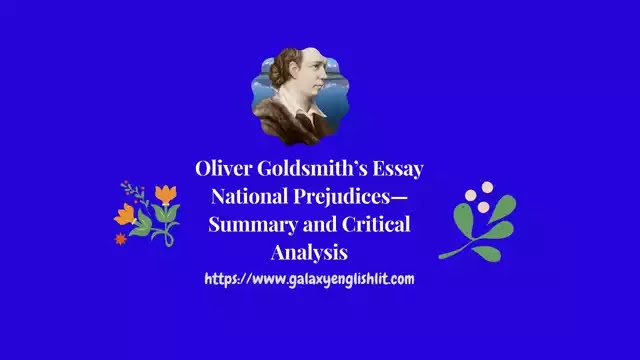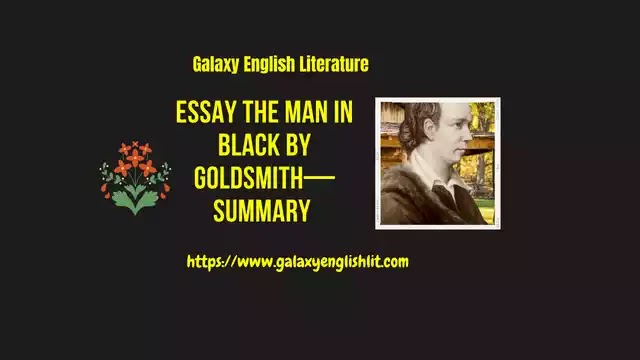Critical Appreciation of the Poem:
Introduction:
Irish American poet, James Patrick Kinney uses his poetic parable, ‘The Cold Within’ to illustrate the folly of falling prey to discrimination. The Cold Within is a poem that states the never ending stinginess and ego of human beings. A white person has agony with the black while the black one wants to take revenge therefore they don't put their logs of wood in the dying fire. Likewise all other also kept their log with themselves out of greed and agony and die holding the logs in their hands not of the cold weather but of no warmth i.e., cold in their hearts.
 |
| Poem The Cold Within—Critical Appreciation |
The poem was written in the 1960s. During the African American Civil Rights Movement (1954-1968), Kinney was outraged by inhuman discriminatory attitudes at the time and wrote this poem to prompt some serious soul searching. In the poem the poet points out how often we are wise enough to rise above our egos and how foolish we are when we give in to our prejudices. Its message is relevant even today, when we face divisive outlooks in the world that lead to hatred and violence. The poem is a reminder to overcome our personal demons and be open to the wisdom of an egalitarian view - an attitude where everyone is considered equal in worth.
Thought - Content:
In the first stanza, the poet describes how six persons were entrapped by chance in a bitter cold. They felt themselves in a grave situation. In a place which seemed to be wholly desolated and there was nothing that could provide them shelter from the biting cold. There was only a dying fire which could keep them warm and save from the bitter cold. Each of them had a stick of wood, but no one tried to keep the fire alive by adding fuel in it with the stick because they had their own reasons not to do so.
In the second stanza the poet describes about the first man who did not want to give away his stick as he had noticed the black man sitting round the fire. Due to having the feelings of hatred and bitterness for the black man he did not want to use his stick into the dying fire. He showed no interest in saving the life of the black man.
In the third stanza, the poet describes the second man who held back his stick as one of them he had noticed, did not belong to his religion. He suffered from intolerance.
In the fourth stanza, the poet describes the third man who was very poor man in tattered clothes. His bitterness and envy for the rich forced him to hold back his stick. He thought that his stick should not be used to warm the rich man. In the fifth stanza, the poet describes the fourth man who was a rich man. He held back his stick because he wanted to keep his wealth away from the undeserving lazy poor persons. The rich man seemed to be the victim of greediness and stinginess.
In the sixth stanza, the poet describes the fifth man who was the black and was full of hatred for the white people community. By holding back his stick, he wanted to hurt the white.
In the seventh stanza, the poet describes the sixth man who was very selfish. He believed in giving to those who gave him first. When he saw that no one was ready to add the fuel in the dying fire with his own stick, he held his stick back.
In the final stanza, the poet describes the tragic death of the six persons. As the fire extinguished, all the men died. The poet points out that they died not from freezing cold outside but of cold within them.
Moral of the Poem:
Through his poem, the poet wants to highlight how the man gives in to discrimination and prejudices which govern all his thoughts and deeds. By the example of a group of six people sitting around a fire holding a stick each, the poet allows the reader to know the psyche of each of them. How each of them is prejudiced and holds back his stick which is needed to let the fire go on. The white hates the black and the rich is contemptuous of the poor. Their hatred is stronger than the genuine need of the hour , i.e. , to let the fire go on . Ultimately the fire dies out and the poet makes it clear that it was not due to the cold outside, but it was due to the cold within that refrained each of them to use his stick to keep the fire going. Through this poem, the poet convinces us that the cold - heartedness and the differences based on caste, creed, colour and religion lead nowhere but to complete downfall.
Form and Structure of the Poem:
The poet employs the medium of prose poetry - a kind of narrative poetry that is a hybrid of a poem and very short story to protest against bigotry and racism. Each stanza has four lines and two sentences with eight syllables, then another two with six, back and forth. In the first and last stanzas, there is a different tone when compared to the rest of the poem. The first is used like an introduction, or exposition, to a story. The last is used as a conclusion, or resolution. However, the use of form and rhythm creates the work into a poem. The speaker shifts tones in the first stanza because the rest of the poem is the actual lesson being taught and the last stanza is the overall big picture.
Diction in the Poem:
In the poem, the poet uses diction to project his point. The line that the poet starts his poem with is ‘six humans trapped by happenstance’. His diction in this line is very important to the overall theme of the poem. By saying ‘six humans’, it is almost as if he is talking about all humans. Another curious use of diction is by saying ‘trapped in happenstance’. ‘Happenstance’ means an event that might have been arranged although it is accidental. This use of diction is important because by saying that it is accidental, yet almost seems arranged, gives the reader a sense that they are supposed to be there. The fact that he says they are trapped suggests that they do not want to be in the situation, but they cannot escape.
Figurative Language:
The poet has used the figure of speech metaphor in the following line:
‘Their dying fire in need of logs.’
‘Their dying fire in need of logs’ not only literally means the fire that is keeping them warm, but also stands as a metaphor for their sinful souls. They are committing sins such. By saying they need to add logs to the fire suggest that they need to help out someone other than themselves, or they will freeze to death.
The poet has used the figure of speech personification in the following line:
‘Their logs held tight in death's still hands. "
‘Death’ has been personified here by putting an apostrophe and ‘s’ in death. It helps dignify the seriousness of the situation as if death was leading the people on, wanting them to come.
The poet has used the figure of speech oxymoron in the following line:
‘The last man of this forlorn group.’
The poet has used alliteration in the following lines:
1. ‘In bleak and bitter cold.’
2. ‘For, of the faces round he fire.’
The use of Imagery:
The poet has made a skilful use of visual imagery to engage the reader. There are following examples of visual imagery:
1. ‘In dark and bitter cold.’
2. ‘The dying fire.’
3. ‘The first one held his back.’
4. ‘He noticed one was black.’
5. ‘The third one sat in tattered clothes.’





